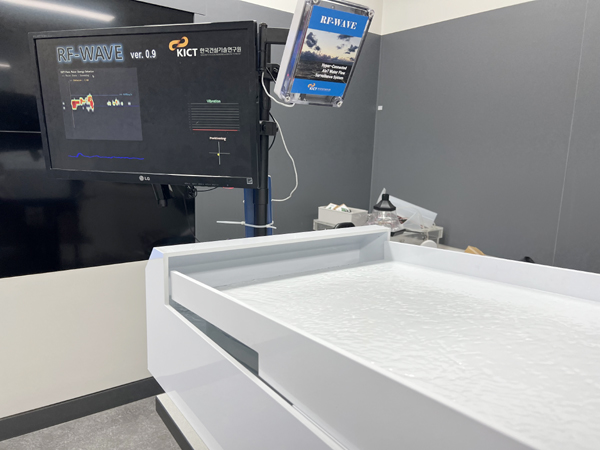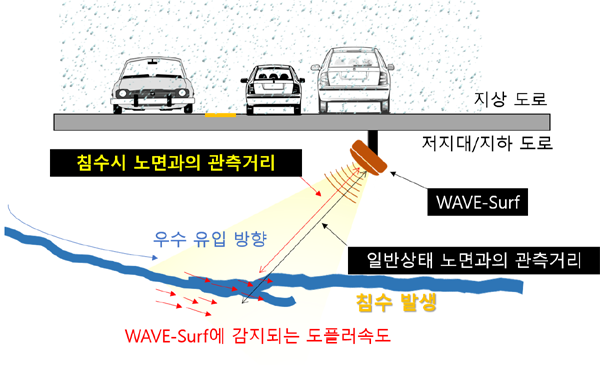Direct monitoring of submerged situations. Development of micro-sensors and platforms that give real-time warning notifications

Smart city safety management technology to respond to urban flooding disasters caused by heavy rains in summer is expected to play a role in developing, monitoring and responding to urban flooding.
The Korea Institute of Civil Engineering and Building Technology (President Kim Byeong-seok/hereinafter referred to as Construction Research Institute) announced on the 10th that it has developed a micro-sensor and platform technology that can constantly monitor the flooding of low-lying houses and underground facilities such as underground roadways, underground parking lots, and road culverts and warn of danger in case of flooding.
In August of last year, three members of a family died due to flooding in a semi-basement house in Sillim-dong, Seoul due to heavy rain. Also, due to the influence of Typhoon Hinnamno in September, there was an accident in which nine people were killed by rainwater that suddenly flowed into an apartment in an underground parking lot in Indeok-dong, Pohang-si.
In the case of such urban flood damage, the cases of 'inland water flooding' due to exceeding the drainage limit of drainage facilities due to localized heavy rain were more than three times higher than 'outside flooding' such as river flooding. Rainwater overflowing from drainpipes cannot seep into the ground and flows directly to lowlands, resulting in rapid flooding.
Currently, the central and local governments are making efforts to prevent flooding accidents through intensive maintenance of drainage facilities in summer. An urban flood monitoring system is in operation based on data such as flood measurement, rainfall observation stations, predicted rainfall, and CCTV images.
However, in a complex urban environment, it is difficult to directly monitor the flooding situation in individual units for low-lying houses, underpasses, underground parking lots, and other underground facilities and passageways.

Diagram of smart safety technology. Photo courtesy of Korea Institute of Civil Engineering and Building Technology.
Accordingly, the research team of the Future Smart Construction Research Division (team leader Dr. Jang Bong-joo) of the Construction Research Institute developed a micro-sensor and platform that can directly monitor flooding situations in various parts of the city and give warning notifications in real time. Through industrial radar and signal processing algorithms, this technology can accurately distinguish complex and fast-changing surroundings such as people and cars and inflowing rainwater, and can calculate the inundation level and inflow speed of rainwater in units of 1cm.
The research team named this technology 'WAVE-Surf (Waterlevel And VElocity based Surveillance system for Urban & Road Flooding)', implying that it is a radar-based urban flood monitoring technology.
This technology is an improved version of RF-WAVE (RainFall, Water-level And VElocity), which was developed by the research team for monitoring floods in small rivers and valleys, to suit the urban environment.
In addition, based on the pre-set dangerous flooding level and the self-calculated flooding speed, it can judge the danger and promptly send a warning notification to guide quick evacuation. In addition, by using the IoT function installed in the device to collect the on-site weather conditions, it is possible to determine whether the current flooding is due to rainfall or other causes.
The developed technology is characterized by being able to respond immediately by directly observing the water level on the spot, unlike existing CCTV video analysis or indirect analysis methods that depend on precipitation. As a result, it is expected to be of great help in monitoring and responding to urban flooding as it can provide fast and accurate flood information in emergency situations.
The research team plans to establish standards for advancement and performance of the developed technology through demonstration tests assuming various submerged environments. In addition, we are working together to provide accurate flood risk information by combining detailed on-site information based on digital twins.
“The developed technology is a smart city safety management technology to respond to urban flooding disasters caused by heavy rains in the summer,” said Kim Byeong-seok, president of the Construction Research Institute.
Meanwhile, this achievement was carried out with the support of 'Digital Twin Test Bed Establishment (2022-2025)' among the national R&D projects of the Ministry of Science and ICT (Information and Communications Technology Evaluation and Planning) and 'Digital Pairing Key Element Technology Development for Water Disaster Monitoring and Utilization of Water Resources (2019-2020)' among the major projects of the Korea Institute of Civil Engineering and Building Technology (XNUMX-XNUMX).



